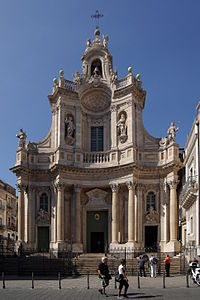Home - In and around
THE BASILICA MARIA SANTISSIMA DELL'ELEMOSINA IN CATANIA
The Basilica Maria Santissima dell'Elemosina, better known as the Collegiata basilica, is a late Baroque church located along Via Etnea, a short distance from the University building, in Catania, in the Collegiate Basilica - San Giuliano district.
The church stands on an ancient pagan temple dedicated to Proserpina.
The bell tower facade (typical of the Sicilian tradition) is on two orders and in the first order has six stone columns, surmounted by a balustrade. In the second order there is a central window and on the sides four large statues of St. Peter, St. Paul, St. Agatha and St. Apollonia. On the second order a central element houses the bells.
The church is accessed by a large staircase, on which, to mark the churchyard, is a wrought iron gate
The interior has a basilica plan with three naves, delimited by eight pillars, and three apses, of which the central one is considerably lengthened for the construction of the canonical choir, second in importance only to those of the cathedral.
In the right aisle we find the baptistery and then three altars with paintings representing St. Apollonia and St. Euplio of Olivio Sozzi and a Martyrdom of St. Agatha by Francesco Gramignani. At the end of the nave is the altar of the Immaculate Conception, protected by a marble balustrade, on which a marble statue of the Madonna is placed.
In the apse of the central nave there is the high altar with an icon of the Madonna with Child, a copy of the Byzantine icon of the Madonna called of the Alchemy (of Misericordia) venerated in the collegiate basilica sanctuary of Biancavilla (CT). Behind the high altar there is an 18th-century wooden organ. Later a wooden choir with 36 stalls, and on the side two canvases by the painter Giuseppe Sciuti.
In the aisle on the left in the apse is the chapel of the Blessed Sacrament with marble altar. Continuing we meet three other altars with paintings representing St. John of Nepomuk, the Holy Family and St. Francis de Sales.
In 1896 Giuseppe Sciuti painted the vault and the dome of the church with different images of the Blessed Virgin Mary, angels and saints.
source wikipedia
The church stands on an ancient pagan temple dedicated to Proserpina.
The bell tower facade (typical of the Sicilian tradition) is on two orders and in the first order has six stone columns, surmounted by a balustrade. In the second order there is a central window and on the sides four large statues of St. Peter, St. Paul, St. Agatha and St. Apollonia. On the second order a central element houses the bells.
The church is accessed by a large staircase, on which, to mark the churchyard, is a wrought iron gate
The interior has a basilica plan with three naves, delimited by eight pillars, and three apses, of which the central one is considerably lengthened for the construction of the canonical choir, second in importance only to those of the cathedral.
In the right aisle we find the baptistery and then three altars with paintings representing St. Apollonia and St. Euplio of Olivio Sozzi and a Martyrdom of St. Agatha by Francesco Gramignani. At the end of the nave is the altar of the Immaculate Conception, protected by a marble balustrade, on which a marble statue of the Madonna is placed.
In the apse of the central nave there is the high altar with an icon of the Madonna with Child, a copy of the Byzantine icon of the Madonna called of the Alchemy (of Misericordia) venerated in the collegiate basilica sanctuary of Biancavilla (CT). Behind the high altar there is an 18th-century wooden organ. Later a wooden choir with 36 stalls, and on the side two canvases by the painter Giuseppe Sciuti.
In the aisle on the left in the apse is the chapel of the Blessed Sacrament with marble altar. Continuing we meet three other altars with paintings representing St. John of Nepomuk, the Holy Family and St. Francis de Sales.
In 1896 Giuseppe Sciuti painted the vault and the dome of the church with different images of the Blessed Virgin Mary, angels and saints.
source wikipedia



